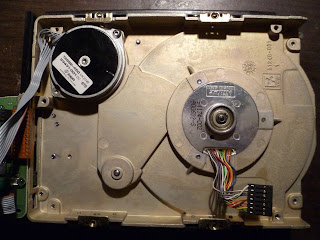As the storage capacity of the hard disk drives emerges with no apparent limit (all hail Moore's law), old disks get obsolete no matter how ground-breaking they were a couple of years ago. I decided to collect some of the old hard disk drives here so that at least their memory would be conserved. The only selection rule for showing an old HDD I had is that I have to have that one somewhere at home :) so my choices will not be equalized in any sense, including technology, manufacturer and so on.
 The first one I found is a Seagate ST-251 from 1994. Using MFM coding, this device was capable of a fantastic 40MB storage space using 6 heads on 3 plates. The maximum transfer rate is 625KB/s with its ST-412 MFM controller. It is an interesting fact that Seagate keeps a good record of its old products, even such an old device is on their webpage here.
The first one I found is a Seagate ST-251 from 1994. Using MFM coding, this device was capable of a fantastic 40MB storage space using 6 heads on 3 plates. The maximum transfer rate is 625KB/s with its ST-412 MFM controller. It is an interesting fact that Seagate keeps a good record of its old products, even such an old device is on their webpage here.
These 5.25" units with their massive metallic case indeed represent some sort of everlasting elegance :)
Even though the electronics of the hard drive was restricted to the most basic functionality (and the rest was done by the control card) it seems quite complex: many application-specific ICs and lots of miscellaneous circuit elements can be spotted.
 The PCB connector itself is a long time extinct part: on the left, the 34 pol connector is allocated for the MFM control signals, whereas the 20 pol on the right is for the MFM data R/W signals. The jumpers in the middle are dedicated to set the address of the drive, making it possible to chain up to 4 drives in a computer. Note that the power connector is already the standard PATA 4 pin connector supplying 5V/12V. An interesting consequence of the separate control card is that the bad sectors found during factory testing are printed on the case of the drive with the corresponding C/H/S values. Nowadays such maps are stored by the HDD electronics.
The PCB connector itself is a long time extinct part: on the left, the 34 pol connector is allocated for the MFM control signals, whereas the 20 pol on the right is for the MFM data R/W signals. The jumpers in the middle are dedicated to set the address of the drive, making it possible to chain up to 4 drives in a computer. Note that the power connector is already the standard PATA 4 pin connector supplying 5V/12V. An interesting consequence of the separate control card is that the bad sectors found during factory testing are printed on the case of the drive with the corresponding C/H/S values. Nowadays such maps are stored by the HDD electronics. After removing the PCB, we get a good sight to the two motors. The one in the middle spins the plates at 3600 rpm and is most likely a brushless 3 phase motor. The other one in the corner is a stepper motor and moves the R/W heads above the plates. While steppers have eventually been replaced by more compact and lightweight solutions, the plate spinner motors are essentially the same even nowadays (they might be a bit smaller though).
After removing the PCB, we get a good sight to the two motors. The one in the middle spins the plates at 3600 rpm and is most likely a brushless 3 phase motor. The other one in the corner is a stepper motor and moves the R/W heads above the plates. While steppers have eventually been replaced by more compact and lightweight solutions, the plate spinner motors are essentially the same even nowadays (they might be a bit smaller though).
These old and robust devices did not really follow today's trend of being low-power and silent. According to the data sheet, it consumes up to 12W and has a characteristic head-bang noise when starting up which is a result of the head calibration process in order to find track0. As a conclusion watch the video I made with the clean area cover removed so that we can see what is going on.






I used one of these for a dual drive modification of the Atari SH 204 hard drive for the Atari ST. It added a massive 40 megs to the 20 megs of the SH 204! Just tried to boot it up and found that the ST-251 cannot be accessed. Internal drive in the SH 204 still works!
ReplyDeleteThis comment has been removed by the author.
ReplyDeleteThank you for your information.
ReplyDeleteThe spindle motor, Nidec 54174-002, in center has 14pin connector(12wire). I don't know this connector pin's name. Let me know this signal name, please.
I stumbled upon this fascinating blog post about vintage hard drives, specifically the Seagate ST-251. It's incredible to see how far technology has come since then. While reminiscing about the past, I couldn't help but think about the present, and I'm excited to share my thoughts on the Seagate SkyHawk AI 20TB.The mention of the Seagate SkyHawk AI 20TB caught my attention, and I must say, Seagate has continually impressed me with their advancements. The SkyHawk AI series, in particular, seems like a game-changer with its 20TB capacity. The blend of high capacity and artificial intelligence features is a testament to how storage solutions have evolved to meet the demands of modern computing.
ReplyDelete